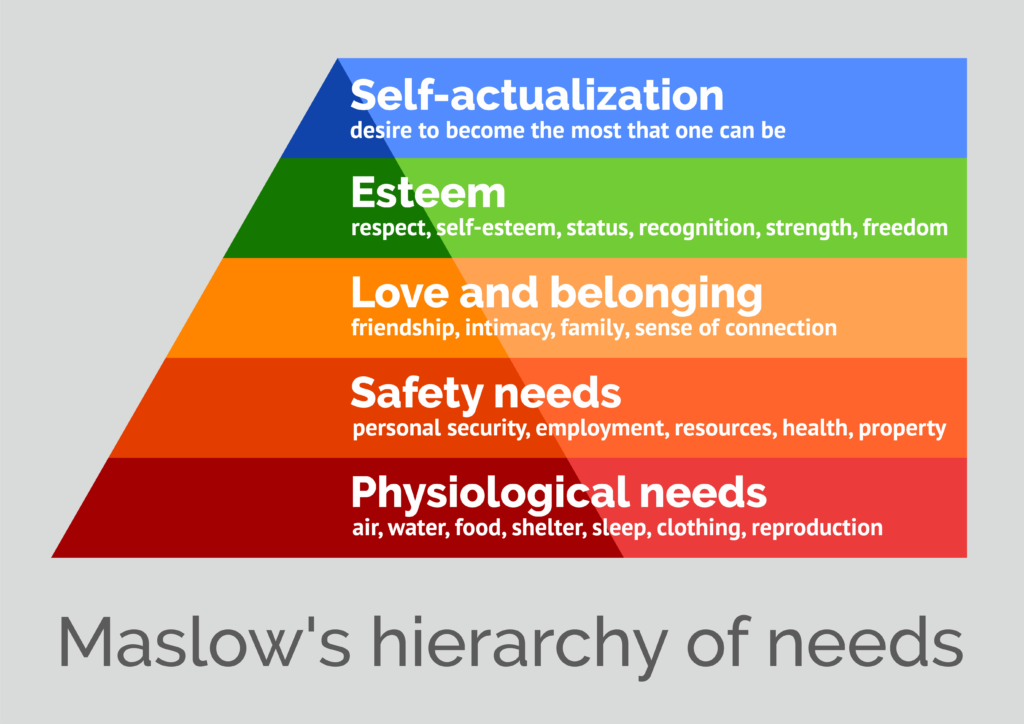Work/life balance, setting boundaries, being successful, none of this can be accomplished until you are willing to pause and take a look at how you are living your life. Looking at the way you have your life set-up and honestly assessing whether or not your needs are actually being met is critical. Managing ourselves requires acknowledging that we have needs and addressing those needs on a regular basis. One of the tools we can use to assess ourselves and gain clarity is Maslow’s hierarchy of needs.
Abraham Maslow, an American psychologist in the early 40s, created this hierarchy as part of his theory on human motivation. Maslow’s theory recognizes that we have particular basic needs because we are human. Needs are part of the human experience. There are times we feel hungry, tired, lonely, etc. These feelings communicate to us that there is an unmet need. However, in order for us to recognize our needs in any given moment, we need to be connected to our bodies, our feelings, and the sensations we feel in our bodies (i.e., your foot falling asleep is your body communicating you need to shift postures).
In Maslow’s hierarchy of needs there are five levels. Each level of the hierarchy is associated with a different set of needs. Maslow’s theory suggests that for us to progress up the hierarchy, we have to fulfill the needs at each level at least in part so we are able to move up the hierarchy. For example, you could have a great skill, but without shelter, you wouldn’t be able to cultivate that skill, refining it, because you would be too occupied with trying to find some place to sleep.
Here are the different levels of Maslow’s hierarchy of needs:

Maslow’s hierarchy of needs starts at the bottom of the triangle with the needs necessary to keep us alive.
Level 1: Physiological Needs
Level 1 is foundational to our survival. It is our most powerful motivator. With our basic needs being fulfilled, there is a chance that we can be expected to accomplish greatness; we are just too consumed with finding food. Maslow’s theory is that these needs have to be fulfilled. Otherwise, the individual will be too preoccupied to be interested in their health or safety.
Level 2: Safety Needs
Level 2 addresses our basic need of wanting to feel safe. We do not want to feel threatened when we wake up in the morning or walk into the office. We feel safe when our environment has some form of predictability. Feeling safe also is about how financially secure we feel. We feel safe when we feel like we have the resources we need to meet any challenge we might face.
It is quite true man lives by bread alone–when there is no bread.
https://www.motivationalmagic.com/library/ebooks/motivation/maslow_a-theory-of-human-motivation.pdf
Level 3: Love and Belonging
Level 3 highlights our need for connection. We need people. Friendship, intimacy, family, and community connections fulfill our human need to belong. Our resilience has long been connected to the connections we have in our lives. Friends matter.
Level 4: Esteem Needs
Level 4 is about us fulfilling our purpose in life. We all have a desire to achieve, to be good at something. And people knowing we are good at something is important to us. We have the need to feel confident, strong, and worthy. Additionally, we thrive when we are treated with dignity and respect, which often comes with being good at a specific skill.
Level 5: Self-actualization Needs
Level 5 is the highest level on the triangle. We reach this level once we have our needs fulfilled from Levels 1-4. Once this occurs, we become inspired to create. Because we are no longer worried about food, water, shelter, safety, friends, and being respected by others, we become curious about our world. The desire to explore our world inspires us. We explore the world in different ways. Through writing, painting, taking a drive…we dream. We dream about who we might become and what it will take to get there. We have the time to learn, appreciate, and reflect on meaning.
What does all this mean today?
Consider Maslow’s hierarchy of needs as a tool for us to use when we are questioning what is getting in the way of us being successful. What is getting in the way of our relationships, our productivity, our ability to balance work and our lives?
Then, using Maslow’s hierarchy of needs, we can pause to consider what might be lacking within the hierarchy of our needs. As leaders, our ability to acknowledge our human needs, some may even say limitations, gives us access to great wisdom. There is wisdom already here, existing in our bodies, encouraging us to honor the boundaries of these needs, at least because to do so is to honor our own human experience mindfully.








